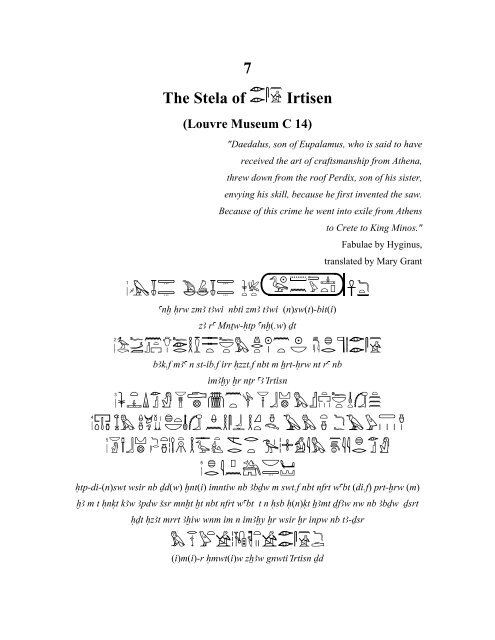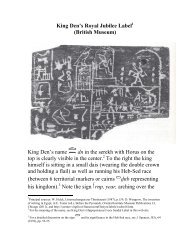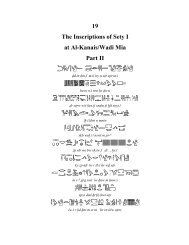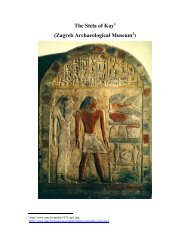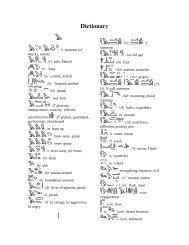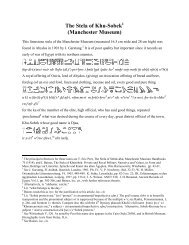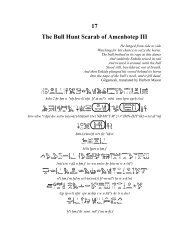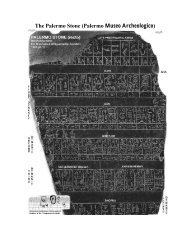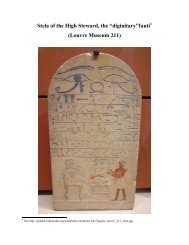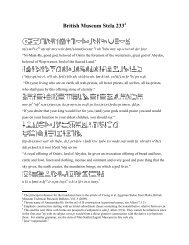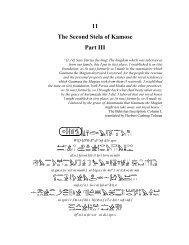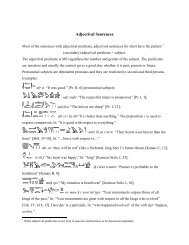7 The Stela of Irtisen - Middle Egyptian Grammar through Literature
7 The Stela of Irtisen - Middle Egyptian Grammar through Literature
7 The Stela of Irtisen - Middle Egyptian Grammar through Literature
Create successful ePaper yourself
Turn your PDF publications into a flip-book with our unique Google optimized e-Paper software.
7<br />
<strong>The</strong> <strong>Stela</strong> <strong>of</strong> <strong>Irtisen</strong><br />
(Louvre Museum C 14)<br />
"Daedalus, son <strong>of</strong> Eupalamus, who is said to have<br />
received the art <strong>of</strong> craftsmanship from Athena,<br />
threw down from the ro<strong>of</strong> Perdix, son <strong>of</strong> his sister,<br />
envying his skill, because he first invented the saw.<br />
Because <strong>of</strong> this crime he went into exile from Athens<br />
to Crete to King Minos."<br />
Fabulae by Hyginus,<br />
translated by Mary Grant<br />
anx Hrw zmA tAwi nbti zmA tAwi (n)sw(t)-bit(i)<br />
zA ra MnTw-Htp anx(.w) Dt<br />
bAk.f mAa n st-ib.f irr Hzzt.f nbt m Xrt-Hrw nt ra nb<br />
imAxy xr nTr aA Irtisn<br />
Htp-di-(n)swt wsir nb Dd(w) xnt(i) imntiw nb AbDw m swt.f nbt nfrt wabt (di.f) prt-xrw (m)<br />
xA m t Hnqt kAw Apdw Ssr mnxt xt nbt nfrt wabt t n Hsb H(n)qt XAmt DfAw nw nb AbDw Dsrt<br />
HDt HzAt mrrt Axiw wnm im n imAxy xr wsir xr inpw nb tA-Dsr<br />
(i)m(i)-r Hmwt(i)w zXAw gnwti Irtisn Dd
iw(.i) rx.kw sStA n mdw-nTr sSmt- aw nw HAbyt HkA nb<br />
apr.n(.i) sw nn swAt im Hr.i<br />
ink grt Hmww iqr m Hmt.f pr Hr-tp m rxt.n.f<br />
iw(.i) rx.kw r(A)w-bAgw fAt nt tp-Hsb<br />
Sdt saqt m pr(.f) aq.f r iiw Ha r st.f<br />
iw(.i) rx.kw Smt twt nmtt rpyt<br />
aHaw nw A 11 ks At n sqr wat(y) dgg irt n snnwt.s ssnD Hr n rst<br />
fAt a nt xAa xAb nmtt pHrr<br />
iw(.i) rx.kw irt imywt xwt hAAt.(s)n<br />
nn rdt mAx.sn (in) xt n(i) ia.(s)n (i)n mw grt<br />
nn pry Xr.s n bw-nb wp(w) Hr.i wa.kw Hna zA.i smsw n xt.i<br />
wD.n nTr ir.f pr n.f Xr.s<br />
iw mAn(.i) prt awi.f m irt (i)m(i)-r kAt m aAt nbt Spst<br />
HAt-r HD Hna nbw pHwi-r Ab(w) r hbn(i)
prt-xrw (m) xA m t Hnqt Apdw kAw Ssr mnxt xt nbt nfrt wabt n imAxy Irtisn iqr mAat xrw<br />
ms.n Idt mAat xrw
<strong>The</strong> <strong>Stela</strong> <strong>of</strong> <strong>Irtisen</strong><br />
measure<br />
anx Hrw living Horus<br />
zmA unite<br />
bAk servant<br />
st-ib favorite, wish, affection<br />
Hzi bless, praise<br />
Hsb kind <strong>of</strong> bread<br />
Hsbw reckoning, account,<br />
Dsrt strong ale<br />
H(n)qt XAmt kind <strong>of</strong> beer<br />
DfAw provisions<br />
HDt HzAt milk (lit. whiteness)<br />
<strong>of</strong> Hezat (cow goddess)<br />
inpw Anubis<br />
tA-Dsr Sacred Land (necropolis)<br />
Hmwti craftsman<br />
zXAw scribe<br />
, gnwti sculptor<br />
sStA make secret, mysterious;<br />
(noun) secret<br />
mdw-nTr hieroglyphs<br />
sSmi guide, lead<br />
HAbyt festival <strong>of</strong>ferings<br />
HkA magic (<strong>of</strong>ten plural)<br />
Vocabulary<br />
apr equip, provide<br />
, , swAi pass<br />
Hmww craftsman<br />
r(A)w-bAgw proportions<br />
<strong>of</strong> thickness (in liquid)<br />
, fAi raise, lift up, carry,<br />
support, weigh<br />
instant<br />
, Hsb count<br />
, Smi go, walk<br />
twt image, figure, statue<br />
nmtt stride, movements, journeys<br />
, rpyt female statue<br />
aHaw positions, posture<br />
A bird (generic)<br />
, ksi bend/bow down, prostrate<br />
, At moment (<strong>of</strong> attack),<br />
sqr smite, strike down<br />
wAt(y) captive, prisoner<br />
dgi look, glance, see, behold<br />
rst (sacrificial) victim<br />
xAa throw, thrust, harpoon<br />
xAb hippopotamus<br />
pHrr run, (noun) runner<br />
imyt pigment
urn<br />
hAAt incrustation, enamel<br />
, mAX/mAx<br />
pri go up, go forth, come out,<br />
come forth, ascend, emerge, renowned<br />
wpw Hr except, but (lit.<br />
separated from)<br />
wAi be alone<br />
Xt body, belly<br />
wD command, assign, bestow, ordain,<br />
decree<br />
(i)m(i)-r kAt overseer <strong>of</strong> work<br />
… HAt-r…pHwi-r beginning…to the<br />
end<br />
aAt precious stone<br />
, HD silver<br />
, nbw gold<br />
, Abw ivory<br />
, hbni ebony
<strong>The</strong> <strong>Stela</strong> <strong>of</strong> <strong>Irtisen</strong><br />
<strong>Grammar</strong> Points<br />
"So, Minos, moved to cover his disgrace, resolved<br />
to hide the monster in a prison, and he built with<br />
intricate design, by Daedalus contrived, an architect<br />
<strong>of</strong> wonderful ability, and famous. This he planned <strong>of</strong><br />
mazey wanderings that deceived the eyes, and labyrinthic<br />
passages involved. so sports the clear Maeander, in the<br />
fields <strong>of</strong> Phrygia winding doubtful; back and forth it<br />
meets itself, until the wandering stream fatigued, impedes<br />
its wearied waters' flow; from source to sea, from sea to<br />
source involved. So Daedalus contrived innumerous paths,<br />
and windings vague, so intricate that he, the architect,<br />
hardly could retrace his steps."<br />
Metamorphoses: Book 8; Minos & Scylla by Ovid,<br />
translated by Brooke Moore<br />
anx Hrw zmA tAwi nbti zmA tAwi (n)sw(t)-bit(i) zA ra MN*W-@&P anx(.w) Dt<br />
<strong>The</strong> stela starts with the royal titulary 1 <strong>of</strong> Mentuhotep II (11 th Dynasty, 2055-2004 BC).<br />
bAk.f mAa n st-ib.f irr Hzzt.f nbt m Xrt-Hrw nt ra nb imAxy xr nTr aA Irtisn<br />
Irtysen, the owner <strong>of</strong> this stela introduces himself as bAk mAa “humble servant” (lit. true<br />
servant) <strong>of</strong> the King with transparent grammar. st-ib is a phrase for “favorite,” irr “who<br />
does” is the imperfective active participle <strong>of</strong> the 3ae-inf. verb iri “do, make,” and Hzzt.f<br />
“what he holds worthy (<strong>of</strong> praise)” is a feminine imperfective relative form <strong>of</strong> the 3-aeinf.<br />
verb Hzi “bless.” <strong>The</strong> imperfectives are used here to emphasize that devotion to the<br />
1 See Gardiner, Excursus A, pp. 71-76, and Allen, Essay 6. For the royal titularies <strong>of</strong> Senwosret III and<br />
Amenhotep III see also Chapters 8 and 20 in this web site.
King is an ongoing, continual action. This devotion is further underlined by the attached<br />
adverbial phrase Xrt-Hrw nt ra nb “in the course <strong>of</strong> every day” (with Xrt, a feminine nisbe).<br />
Finally, A imAxy xr B is a frequently occurring phrase: “A is worthy <strong>of</strong> respect <strong>of</strong> B. 2 ”<br />
Htp-di-(n)swt wsir nb Dd(w) xnt(i) imntiw nb AbDw m swt.f nbt nfrt wabt (di.f) prt-xrw (m)<br />
xA m t Hnqt kAw Apdw Ssr mnxt xt nbt nfrt wabt t n Hsb H(n)qt XAmt DfAw nw nb AbDw Dsrt<br />
HDt HzAt mrrt Axiw wnm im n imAxy xr wsir xr i(n)pw nb tA-Dsr<br />
<strong>The</strong> stela continues with the well-known Htp-di-nswt dedicatory formula. 3 One only needs<br />
to mention the missing imperfective di.f or di.sn, and the missing m “consisting <strong>of</strong>” in<br />
front <strong>of</strong> xA.<br />
<strong>The</strong> indirect genitive t n Hsb probably refers to a kind <strong>of</strong> bread (alternatively, Hsb(w) may<br />
refer to “measure, ration” so that this noun phrase could mean “bread <strong>of</strong> measure),” while<br />
H(n)qt XAmt is a kind <strong>of</strong> beer. <strong>The</strong> list continues with DfAw “provisions” (general), Dsrt<br />
“strong ale,” and HDt HzAt “milk <strong>of</strong> the cow-goddess Hezat” (lit. “whiteness <strong>of</strong> Hezat”).<br />
Once again mrrt X “what X like(s)” (with X here being the akhs, the deceased who made<br />
a successful transition to afterlife) is a frequently used construction employing the<br />
feminine imperfective relative form <strong>of</strong> the 3ae-inf. verb mri “like, love.” <strong>The</strong> resumptive<br />
pronoun is missing here, actually replaced by im “<strong>of</strong> which” or “where<strong>of</strong>,” a fairly<br />
common practice.<br />
(i)m(i)-r Hmwt(i)w zXAw gnwti Irtisn Dd<br />
Before he speaks, Irtysen introduces himself as the overseer <strong>of</strong> Hmwt “craftsmen,<br />
artisans” (collective noun) and as zXAw “scribe” and gnwti “sculptor.” (<strong>The</strong> last two are<br />
singular, so they refer only to Irtysen himself.)<br />
2 See Allen, Essay 21.<br />
3 See Gardiner, Excursus B, pp. 170-173, and Allen, (24.10).
iw(.i) rx.kw sStA n mdw-nTr sSmt- aw nw HAbyt HkA nb apr.n(.i) sw<br />
nn swAt im Hr.i<br />
Irtysen’s speech starts with the subject-stative construction iw(.i) rx.kw “I know” using<br />
the stative <strong>of</strong> the 2-lit. verb rx with (exceptional) active meaning. This self-laudatory<br />
approach is an essential feature <strong>of</strong> this kind <strong>of</strong> stela (and tomb inscriptions), in fact, iw(.i)<br />
rx.kw is repeated in the text three more times. <strong>The</strong> long list <strong>of</strong> Irtysen’s know-how’s<br />
begins with the most important scribal skill, the knowledge <strong>of</strong> mdw-nTr “hieroglyphs.”<br />
Next in the list, the starting phrase sSmt- aw lit. “guiding the arms” may mean<br />
“accomplish, make happen,” containing the infinitive <strong>of</strong> the caus. 3ae-inf. verb sSmi “lead,<br />
guide” and having HAbyt “festival <strong>of</strong>ferings” as its object. <strong>The</strong> object HkA nb “all magic”<br />
<strong>of</strong> the 3-lit. verb apr “acquire, equip” (in circumstantial sDm.n.f /perfect with omitted<br />
subject) is topicalized (and is referenced by the resumptive pronoun sw). As a final<br />
emphasis, the nn + infinitive construction applied to swAi Hr “pass by” claims Irtysen’s<br />
thoroughness and attention to detail. Note also that according to Gardiner 4 swAt is a<br />
participle occurring in a “negative universal proposition” with literal meaning “there is<br />
none there<strong>of</strong> that passes by me.”<br />
“And I have filled him with the spirit <strong>of</strong> God,<br />
in wisdom, and in understanding, and in knowledge,<br />
and in all manner <strong>of</strong> workmanship,<br />
To devise cunning works, to work in gold, and in silver, and in brass,<br />
And in cutting <strong>of</strong> stones, to set them, and in carving <strong>of</strong> timber,<br />
to work in all manner <strong>of</strong> workmanship.”<br />
Exodus 31:3-5 Bible, King James Version<br />
ink grt Hmww iqr m Hmt.f pr Hr-tp m rxt.n.f<br />
<strong>The</strong> new passage here starts with an A B nominal sentence: ink grt … (using the enclitic<br />
particle grt “moreover, now”). <strong>The</strong> singular Hmww <strong>of</strong> the collective noun Hmwt (both<br />
derived from Hmt “craft, skill”) used previously identifies Irtysen’s pr<strong>of</strong>ession. <strong>The</strong><br />
4 Gardiner (§394).
perfective active participle pr “who became” <strong>of</strong> the verb pri (again) and the perfect<br />
relative form rXt.n.f “what he learned” <strong>of</strong> the 2-lit. verb rx “learn” are used to state his<br />
superior status in the pr<strong>of</strong>ession.<br />
iw(.i) rx.kw r(A)w-bAgw fAt nt tp-Hsb<br />
Sdt saqt m pr(.f) aq.f r iiw Ha r st.f<br />
<strong>The</strong> text describing the actual skills <strong>of</strong> Irtysen becomes here technical. We first discuss<br />
the grammar and then the possible interpretations. <strong>The</strong> noun rAw-bAgw means<br />
“proportions <strong>of</strong> thickness” (in liquids) with bAgw “weariness, languidness, sluggish,”<br />
probably meaning “sinking” and being descriptively related to the 4ae-inf adjective-verb<br />
bAgi “lazy, weary;” the infinitive fAt <strong>of</strong> the 3ae-inf. verb fAi (used as a noun) means “to<br />
weigh,” and tp-Hsb can be translated as “correct way” (that is, by calculation, since Hsb<br />
means “count, calculate”). This is clearly a description <strong>of</strong> mixing/dissolving certain<br />
substance(s) in water with exact proportions.<br />
<strong>The</strong> next line is vague and difficult to interpret. <strong>The</strong> 3ae-inf verb Sdi “pull out, take,<br />
remove,” and the caus. 2-lit. verb saq “fit in” (lit. “cause to enter”) are in infinitives: Sdt<br />
and saqt. <strong>The</strong> preposition m “(according) as” has object pr(.f ) aq.f. <strong>The</strong> latter contains<br />
the nonattributive perfective relative forms <strong>of</strong> the verbs pri and aq whose subject, the<br />
suffixed pronoun .f applies to both. <strong>The</strong> literal meaning is “according as it emerges and<br />
enters.” (<strong>The</strong> pairing <strong>of</strong> pri and aq is well attested:<br />
5 and<br />
6 .) <strong>The</strong> next clause (which can be introduced using “so that”)<br />
starts with r iiw. could be a rare writing <strong>of</strong> the infinitive iwt, but most<br />
likely it is the emphatic prospective sDmw.f /prospective <strong>of</strong> ii as at the time this verb form<br />
evolved partly into the r + infinitive pseudoverbal construction (and partly into<br />
prospective/subjunctive). <strong>The</strong> noun Ha not only means “body” (in which case it is mostly<br />
5 [Urk. 498, 7].<br />
6 [Urk. 433, 11-12].
plural) but also “part, member.” (One should note that sometimes the body (in plural) and<br />
its members are distinguished:<br />
iw.f n nsrt tkA.s Haw(.f ) n Axt wnm.s awt.f “He is (destined) to fire<br />
that will torch his body, and to flame that will consume his limbs.” 7 ) Thus the phrase in<br />
question can be translated as: “so that (each) member will come in its place.” Putting<br />
everything together, the literal translation <strong>of</strong> the whole passage is: “taking/removing and<br />
fitting in as it comes out/emerges and goes in/enters so that (each) member will come to<br />
its place.” Badawy 8 interprets the whole passage as a description <strong>of</strong> mixing some sort <strong>of</strong><br />
cement and making relief sculpture not by carving but by hollow casting. <strong>The</strong> last<br />
obscure part would fit into this as a complex relief would require molding and demolding<br />
multiple parts.<br />
<strong>The</strong>re is only scanty evidence that the ancient <strong>Egyptian</strong>s were familiar with making<br />
this type <strong>of</strong> relief sculpture. (Using copper and bronze, lost-wax casting was, however, in<br />
practice since the Early Dynastic period. Casting objects in metal such as gold and to<br />
guild statues is well-attested; see for example king Sety I’s Al-Kanais inscriptions<br />
[Kanais C, 9] in this web site.) On the other hand, J. Davidovits used this passage <strong>of</strong> the<br />
Irtysen <strong>Stela</strong> as contributing evidence to his theory that the blocks <strong>of</strong> the pyramids in the<br />
Giza plateau were made <strong>of</strong> a type <strong>of</strong> concrete from a mixture <strong>of</strong> limestone, clay, lime, and<br />
water. But the vagueness <strong>of</strong> the technical description allows several other interpretations.<br />
For example, the first passage may as well refer to mixing paints and the second to the<br />
mortise-and-tenon joints <strong>of</strong> basic carpentry. (<strong>The</strong> Abydos ships near the temple <strong>of</strong><br />
Khentyamentiu clearly show that these types <strong>of</strong> joints were well-employed long before<br />
Irtysen’s time.)<br />
"But Hera was very angry and quarreled with her mate.<br />
And because <strong>of</strong> this strife she bare without union with<br />
Zeus who holds the aegis a glorious son, Hephaestus,<br />
who excelled all the sons <strong>of</strong> Heaven in crafts"<br />
Hesiod, <strong>The</strong> <strong>The</strong>ogany, translated by H.G. Evelyn-White<br />
7 See [Kanais C, 15-16] in this web site.<br />
8 <strong>The</strong> <strong>Stela</strong> <strong>of</strong> Irtysen, Chronique d’Egypte, Bruxelles, Tome XXXVI, pp. 269-276, (1961).
iw(.i) rx.kw Smt twt nmtt rpyt<br />
As the walking legs determinative suggests the infinitive Smt (<strong>of</strong> the 3ae-lit. verb Smi)<br />
should be “gait” (manner <strong>of</strong> walking, stepping, or running) instead <strong>of</strong> “stance” although<br />
the latter would better fit with twt “male statue/figure.” In a nice balance, on the female<br />
counterpart, the meaning <strong>of</strong> the noun nmtt “step,walk” is similar to Smt (and it is clearly<br />
related to the 3ae-verb nmi “travel, traverse”). <strong>The</strong> standing woman is the ideogram for<br />
rpyt “female statue.”<br />
aHaw nw A 11 ks At n sqr wat(y) dgg irt n snnwt.s ssnD Hr n rst<br />
<strong>The</strong> next few passages are beautiful but difficult. First, in the stela we have<br />
instead <strong>of</strong> aHaw “positions, posture,” and the latter is clearly being the case as it is<br />
related to the 3-lit. verb aHa “stand up.” <strong>The</strong> <strong>Egyptian</strong> vulture A carries the meaning <strong>of</strong> a<br />
generic “bird” here. <strong>The</strong> number 11 (proposed by Gardiner) (or even 10) is a bit <strong>of</strong><br />
curiosity here as the number <strong>of</strong> birds in the Manuel de Codage under G is at least the<br />
double <strong>of</strong> this. <strong>The</strong> noun ks “bent position” is once again related to the 3ae-inf. verb ksi<br />
“bend down” (although it may not be the infinitive as the t ending is missing and this<br />
ending has been regularly supplied in other cases). At “instant action, moment, sudden<br />
attack” (with the sun determinative missing) is represented here only with the<br />
hippopotamus head and fits in the situation well. <strong>The</strong> second part <strong>of</strong> the indirect genitive<br />
contains the infinitive <strong>of</strong> the verb sqr “smite, strike down,” and the noun waty “captive,<br />
prisoner.” <strong>The</strong> whole situation depicts the well-known “smiting the enemy” composition<br />
. As the Narmer Palette and many other artifacts depict, the one who strikes the<br />
captive is in standing position, so that ks should refer to wAty and consequently sqr cannot<br />
be an active participle “the bent position <strong>of</strong> one who strikes,” but rather “the bent position,<br />
(at) the moment <strong>of</strong> strike, <strong>of</strong> the captive.” Next, one needs to distinguish between<br />
and , the first being a determinative <strong>of</strong> the verb dgi “look” (with the preposition n<br />
“at” governing the object), and the second the biliteral and ideogram for irt “eye.”
Although one would expect here an infinitive, the verb form dgg is clearly a<br />
nonattributive imperfective relative form and can be translated as: “(I know) how an eye<br />
looks at.” Another example to this is the title <strong>of</strong> Spell 221 in the C<strong>of</strong>fin Texts:<br />
irr z(i) mrrt.f “How a man does what he wants…” 9 <strong>The</strong> object is snnwt.s, lit. “its<br />
second” (the feminine suffix pronoun refers to another eye) and can be translated as<br />
“someone else, another.” <strong>The</strong> caus. 3-lit. verb ssnD “cause/make fearful, frighten, terrify”<br />
is again a nonattibutive relative form with subject Hr “face:” “(I know) how a face<br />
frightens..,” and with object (introduced by the preposition n) the collective feminine<br />
noun rst “(sacrificial) victim.”<br />
fAt a nt xAa xAb nmtt pHrr<br />
<strong>The</strong> infinitive <strong>of</strong> the 3ae-lit. verb fAi “raise, lift up” starts the passage (with the wrong<br />
determinative for “weigh” that occurred earlier). <strong>The</strong> right determinative clearly<br />
conveys the meaning. This infinitive (used as a noun) is the first part <strong>of</strong> a direct genitive<br />
formed with a “arm.” This direct genitive construction, treated as feminine, is imbedded<br />
into an indirect genitive A nt B in which the genitival adjective nt borrows its gender<br />
from fAt a. <strong>The</strong> second noun B in this construction is the perfective active participle “one<br />
who harpoons” <strong>of</strong> the 3-lit. verb xAa “thrust, harpoon.”<br />
iw(.i) rx.kw irt imywt xwt hAAt.(s)n<br />
nn rdt mAx.sn (in) xt n(i) ia.(s)n (i)n mw grt<br />
<strong>The</strong> objects <strong>of</strong> the infinitive <strong>of</strong> iri are the plurals <strong>of</strong> the nouns (in apposition): imyt<br />
“pigment” and xt “thing.” In addition, referring to the process <strong>of</strong> making crusts, inlays<br />
and types <strong>of</strong> enamel, the noun hAAt “incrustation, enamel” is doubtless related to the 3aeinf.<br />
verb hAi “descend” while the 3PL suffix pronoun .sn refers back to imywt xwt.<br />
<strong>The</strong> negative particle nn negates the infinitive <strong>of</strong> rdi. <strong>The</strong> latter starts a rdi + prospective<br />
/subjunctive construction with mAx “burn” in prospective/subjunctive, lit. “without<br />
9 Allen (25.3.6).
causing that they burn (by) fire.” (<strong>The</strong> absence <strong>of</strong> the preposition in is probably for<br />
graphical reasons; the reed leaf is not written even in the next clause and the duplication<br />
<strong>of</strong> is avoided.) Finally, the negated passive expresses negation <strong>of</strong> ability in n(i)<br />
ia.(s)n “they cannot be washed away (by water).”<br />
nn pry Xr.s n bw-nb wp(w) Hr.i wa.kw Hna zA.i smsw n xt.i<br />
wD.n nTr ir.f pr n.f Xr.s<br />
<strong>The</strong> governing verb appearing twice in this passage is the 3ae-inf. verb pri followed by<br />
Xr.s. <strong>The</strong> verb itself has many meanings: “go up, go forth, come out, come forth, ascend,<br />
emerge,” and also “renowned.” <strong>The</strong> preposition Xr “under” indicates possession and the<br />
feminine suffix pronoun .s collectively refers to the (pr<strong>of</strong>essional) knowledge and skills<br />
detailed previously. nn signifies general negation <strong>of</strong> existence, and here, in a nn A<br />
construction, it should be followed by a noun (A) or a phrase that acts as a noun. In fact,<br />
the entire phrase nn pry Xr.s should act as a (masculine) noun, being the first part <strong>of</strong> an<br />
indirect genitive ending with n bw-nb “<strong>of</strong> all the people.” Due to its ending pry cannot be<br />
infinitive; in other parts <strong>of</strong> the stela the t endings for infinitives have been meticulously<br />
spelled out. Following Gardiner pry is most possibly a (masculine singular) perfective<br />
active participle <strong>of</strong> pri written with the rare ending y. 10 One can think <strong>of</strong> pry as a<br />
“participial noun” derived from pri and also interpret the y ending as the scribe’s wish to<br />
emphasize this. As Gardiner states: 11 “<strong>The</strong> more nominal in character the participle is, the<br />
greater the tendency to write the participial ending.” <strong>The</strong> negation nn pry forms what he<br />
calls a “negative universal proposition 12 ” and the entire phrase nn pry Xr.s n bw-nb can<br />
then be translated as “<strong>of</strong> all the people there was none who came forth having the<br />
(pr<strong>of</strong>essional) knowledge.” Emphasizing the nominal character <strong>of</strong> pry we may translate it<br />
as being “distinguished, renowned or outstanding.” With this, the translation can read as<br />
“…there was none distinguished <strong>of</strong>…”<br />
10 Gardiner (§359).<br />
11 Op. cit.<br />
12 Gardiner (§394).
As noted above, the expression bw-nb (the second part <strong>of</strong> an indirect genitive)<br />
emphasizes the uniqueness <strong>of</strong> the knowledge by comparing it to all the people. Exception<br />
is made to Irtysen himself (wp(w) Hr.i “except me,” lit. “separated from”) and to the<br />
eldest son with an easy stative construction involving the 3ae-inf. adjective-verb wai<br />
“alone.” Fatherly affection is emphasized using an indirect genitive using smsw “eldest<br />
(one)” combined with xt.i “my body.” Divine (royal) command (the stela has HD not<br />
wD) for the son to follow his father’s footsteps uses circumstantial sDm.n.f /perfect, and<br />
the following noun clause (expressing subsequent action) is governed by the prospective<br />
/subjunctive <strong>of</strong> iri: “<strong>The</strong> god has commanded that he act as.” This time the verb form <strong>of</strong><br />
pri is less ambiguous, most probably a perfective passive participle pr “one who is<br />
brought forward.” <strong>The</strong> dative refers to the king, and once again Xr.s indicates possession:<br />
“having the knowledge.” Alternatively, if there is a missing suffix pronoun .i after pr:<br />
pr(.i) n.f Xr.s then the sentence becomes active, with the meaning that the King has<br />
ordained the father to handle down his pr<strong>of</strong>essional knowledge to his son, an equally<br />
reasonable circumstance.<br />
iw mAn(.i) prt awi.f m irt (i)m(i)-r kAt m aAt nb(t) Spst<br />
HAt-r HD Hna nbw pHwi-r Ab(w) r hbn(i)<br />
<strong>The</strong> particle iw introduces the main clause in which the governing verb mAA is most likely<br />
in the circumstantial/imperfective sDm.f with the special form mAn. It fits well in the<br />
context as this verb form expresses an action that is generally true (in this case Irtysen’s<br />
son’s efficiency). <strong>The</strong> circumstantial Dm.n.f /perfect mA.n(.i) is also possible. As such it<br />
would point to a completed action, that is, Irtysen’s conviction that his son is worthy to<br />
be considered as his successor. In either case the suffixed subject is omitted. <strong>The</strong> object is<br />
the noun phrase prt awi that uses the (feminie plural) active participle <strong>of</strong> pri, lit. “what<br />
comes out <strong>of</strong> his hands.” It carries the meaning <strong>of</strong> efficiency, ability, as well as results <strong>of</strong><br />
work. <strong>The</strong> m + infinitive construction applied to the verb iri expresses concomitant action<br />
(to mAn(.i)). imi-r kAt “overseer <strong>of</strong> work” is a well-know phrase as well as aAt nbt Spst “all<br />
kinds <strong>of</strong> precious stones/minerals.” HAt-r … pHwi-r is the <strong>Middle</strong> <strong>Egyptian</strong> way <strong>of</strong> writing
“starting…to the end.” One can compare this with the last passage in the Story <strong>of</strong> the<br />
Shipwrecked Sailor . <strong>The</strong> apposition <strong>of</strong> Ab(w) “ivory” and hbn(i)<br />
“ebony” is given inserting the preposition r “to” between them.<br />
prt-xrw (m) xA m t Hnqt Apdw kAw Ssr mnxt xt nbt nfrt wabt n imAxy Irtisn iqr mAat xrw<br />
ms.n Idt mAat xrw<br />
<strong>The</strong> stela ends with the (second part <strong>of</strong> the) well-known funerary formula <strong>of</strong> invocation<br />
<strong>of</strong>fering.<br />
Bibliography<br />
Text: http://upload.wikimedia.org/wikipedia/commons/2/21/Louvre_stele_chef_artisans.JPG<br />
(high resolution photograph).<br />
Commentaries/<strong>Grammar</strong>: A. Badawy, <strong>The</strong> <strong>Stela</strong> <strong>of</strong> Irtysen, Chronique d’Egypte, Bruxelles,<br />
Tome XXXVI, pp. 269-276, (1961); W. Barta, Das Selbstzeugnis eines altägyptischen Künstlers<br />
(Stele Louvre C 14), Münchner Ägyptologische Studien, Verlag Bruno Hessling, Berlin, (1970);<br />
M. Baud, Le métier d’Iritisen, Chronique d’Egypte, Bruxelles, Tome XXV, pp. 21-34, (1938).<br />
Translations: http://www.iut.univ-paris8.fr/~rosmord/hieroglyphes/C14tra.html (French); G.<br />
Maspero, TSBA 5, pp. 559-560, (1877)


